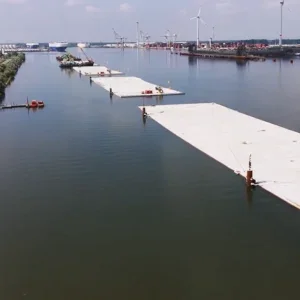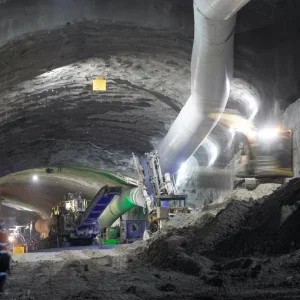Project planning is dependent on local weather, and as such, operational strategies and materials need to be chosen to suit a particular climate.
Extreme weather events can disrupt projects, expose workers to additional risks, and increase construction costs significantly. With the weather becoming much less predictable, this has forced tunnelling projects to prepare for conditions that were once deemed ‘very unlikely’.
Although the face of excavations in deeper and longer tunnels is less susceptible to the effects of extreme weather, the reality is that many auxiliary operations for tunnelling happen outside the tunnel. Even elements of the work inside the tunnel are going to be affected by weather conditions while they get mobilised to the excavation face (concrete, shotcrete, chemical grout, lubricants, ground conditioning material, equipment, etc.).
Extreme weather can also affect the functioning of construction materials or increase the wear and tear of construction equipment. Consider extremely dry conditions which can increase the amount of dust around the site and so can cause machinery damage. The same goes for an exceptionally cold or hot climate where temperatures can reduce the effectiveness of many products typically used for tunnelling.
Construction sites could also be indirectly affected by the weather.
For example, storms and flooding can cause transportation complications and procurement delays. Heavy snowfall can cause disruption to monitoring equipment and result in unsafe conditions for moving equipment and crews. Local disruptions due to weather can also affect how projects source, buy, and transport the materials they need.
Some of the frequent issues which construction crews need to take into consideration during extremely cold or hot weather are as follows:
Concrete pour in hot weather: the problem with hot weather is not actually the heat, as concrete cures through hydration. On a molecular level, cement uses water to grow crystals around the aggregates. Still, when it is too hot (say over 25°C), water evaporates too quickly and does not allow the concrete to consume the required amount of water to go through the proper process of hydration. The outcome is usually a lower strength concrete.
Concrete pour in cold weather: concrete is generally assumed to be exposed to ‘cold weather’ when the average daily air temperature is less than 5°C. In such conditions, concrete needs to be protected from freezing (using curing blankets for example) to reach the necessary strength before formwork can be safely removed.
As a general rule, concrete should not be poured over frozen ground. Instead, heaters can be used to thaw the area. Concrete with a lower slump and minimal water-to-cement ratio would help to reduce bleeding and decreases the setting time in a cold environment. Also, the correct amount of air-entrained voids that resist freezing and thawing effects would be recommended.
Grouting: grouting has numerous applications at tunnelling sites and is similar to concrete in many respects. However, the ratio of water to other material is higher than for concrete, therefore when grout freezes, it exhibits substantial volumetric change (water increases in volume by about 9.05% when changing into ice). This could damage blocks of concrete or other rigid structures if it finds its way into the cracks and joints before freezing.
Ground movement and surface monitoring: These are some of the main components of tunnelling which can be considerably affected by weather. On the surface, rain and snow can always reduce the accuracy of readings by total station. Extremely hot or cold temperatures can result in settlement or heave depending on the geology and water content of the soil. Heavy rain or a high amount of snowmelt can also cause ground movements. For example, soil layers such as expansive clay are prone to substantial volume changes (swelling and shrinking).
There are several other aspects of tunneling construction that can be affected by extreme weather. These include but are not limited to the performance of ventilation equipment, efficiency of sealants, lubricants, ground conditioning foams, and other chemical products. The key to successful site and logistical planning is to look into the climatic conditions affecting the project area early on in the process. This will allow proper project mobilisation so the equipment, products, and methods to be used will achieve the required results in a range of adverse weather conditions.







